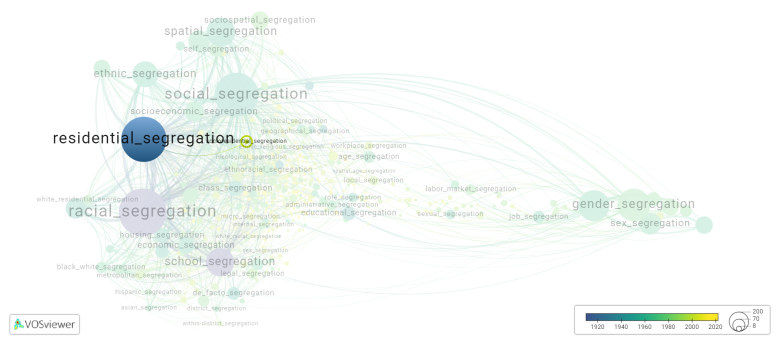Socioresidential segregation
Date and country of first publication[1]
2010
Israel
Definition
Socio-residential segregation refers to the unequal distribution of different social groups in residential areas, typically based on socioeconomic status, race, ethnicity, or other demographic characteristics. This segregation is often the result of historical patterns of discrimination, unequal access to resources, and varying levels of economic opportunity.
Socio-residential segregation can have significant implications for individuals and communities. It can lead to the concentration of poverty in certain neighborhoods, resulting in limited access to quality education, healthcare, employment opportunities, and other essential resources. This can contribute to a cycle of poverty and perpetuate inequality.
Additionally, socio-residential segregation can reinforce social divisions and inequalities by limiting interactions and social connections across different social groups. It can lead to the formation of homogeneous communities, where individuals have limited exposure to diverse perspectives and experiences. This can further perpetuate stereotypes, prejudices, and discrimination.
Efforts to address socio-residential segregation often involve policies and interventions aimed at promoting fair housing, improving access to affordable housing in diverse neighborhoods, reducing discrimination, and providing equal opportunities for all individuals. By promoting more integrated communities, policymakers and advocates aim to foster social cohesion, reduce inequality, and provide equal opportunities for all residents.
Synonyms
The following terms are synonymous with:
social residential segregation; socio residential segregation.
References and literature addressing this segregation form under these synonymous terms can be found below.
See also
Related segregation forms
Socioresidential segregation is frequently discussed in the literature with the following segregation forms:
residential segregation, ethnic residential segregation, urban residential segregation, social segregation, postsocialist segregation, urban segregation, school segregation

For the complete network of associated segregation forms, see:
year of publication https://tinyurl.com/2235lkhw
Louvain clusters https://tinyurl.com/2d8wg5n3
betweenness centrality https://tinyurl.com/223udk5r
disciplines where segregation forms first appeared https://tinyurl.com/244d8unz
References
Notes
- ↑ Date and country of first publication as informed by the Scopus database (December 2023).
At its current state, this definition has been generated by a Large Language Model (LLM) so far without review by an independent researcher or a member of the curating team of segregation experts that keep the Segregation Wiki online. While we strive for accuracy, we cannot guarantee its reliability, completeness and timeliness. Please use this content with caution and verify information as needed. Also, feel free to improve on the definition as you see fit, including the use of references and other informational resources. We value your input in enhancing the quality and accuracy of the definitions of segregation forms collectively offered in the Segregation Wiki ©.
Socioresidential segregation appears in the following literature
Omer I. (201). High Resolution Geographic Data and Urban Modeling: The Case of Residential Segregation. GeoJournal Library, 99(), 15-29. Springer Science and Business Media B.V..https://doi.org/10.1007/978-90-481-8572-6_2
Marcińczak S., Gentile M., Stȩpniak M. (2013). Paradoxes of (post)socialist segregation: Metropolitan sociospatial divisions under socialism and after in Poland. Urban Geography, 34(3), 327-352. https://doi.org/10.1080/02723638.2013.778667
Oberti M., Savina Y. (2019). Urban and school segregation in Paris: The complexity of contextual effects on school achievement: The case of middle schools in the Paris metropolitan area. Urban Studies, 56(15), 3117-3142. SAGE Publications Ltd.https://doi.org/10.1177/0042098018811733
Cortés Y. (2021). Spatial accessibility to local public services in an unequal place: an analysis from patterns of residential segregation in the metropolitan area of santiago, chile. Sustainability (Switzerland), 13(2), 1-20. MDPI AG.https://doi.org/10.3390/su13020442
Goytia C. (2022). LAND MARKETS AND LAND POLICY IN LATIN AMERICA AND THE CARIBBEAN. The Routledge Handbook of Urban Studies in Latin America and the Caribbean: Cities, Urban Processes, and Policies, 143-171. Taylor and Francis.https://doi.org/10.4324/9781003132622-81
Marchant Santiago C., Acuña R.S., Monje-Hernández Y. (2022). LONG TERM FEATURES OF CITIES IN LATIN AMERICA AND THE CARIBBEAN: Socio Residential Segregation, Territorial Inequality, and Spatial Fragmentation. The Routledge Handbook of Urban Studies in Latin America and the Caribbean: Cities, Urban Processes, and Policies, 177-201. Taylor and Francis.https://doi.org/10.4324/9781003132622-10
